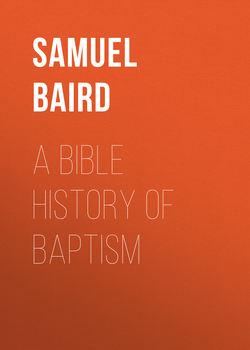Читать книгу A Bible History of Baptism - Baird Samuel John - Страница 6
Book I.
OLD TESTAMENT HISTORY
Part I.
BAPTISM AT SINAI
Section III. —The Old Testament Sacraments
ОглавлениеAs there are no immersions in the Old Testament, we must look for the divers baptisms under some other form. Assuming that in this rite there must be a sacramental use of water, we will first examine the ancient sacraments. On a careful analysis of the ordinances comprehended in the Levitical system, we find among them four which strictly conform to the definition of a sacrament, and which are the only sacraments described or referred to in the Old Testament.
1. Sacrifice.– The first of these in origin and prominence was sacrifice. Originating in Eden, and incorporated in the Levitical system, it had all the characteristics of a sacrament. In it the life blood of clean animals was shed and sprinkled, and their bodies burned upon the altar. Thus were represented the shedding of Christ’s blood, and his offering of atonement to the justice of God. But here is no water. It is not the baptism for which we seek.
2. Circumcision.– The second of the Old Testament sacraments was circumcision, whereby God sealed to Abraham and his seed the covenant of blessings to them and all nations through the blood of the promised Seed. Here, again, no one will pretend to identify the ordinance with the baptisms of Paul.
3. The Passover.– The third of the Old Testament sacraments, the first of the Levitical dispensation, was the feast of the passover. In it, the paschal lamb was slain, its blood sprinkled on the lintels and door posts of the houses, and the flesh roasted and eaten with unleavened bread and bitter herbs. At Sinai, this ordinance was modified by requiring the feast to be observed at the sanctuary, the blood being sprinkled on the altar, and the fat burned thereon. And, to the other elements appointed in Egypt, the general provisions of the Mosaic law added wine. All peace offerings, free will offerings, and offerings at the solemn feasts, of which the passover was one, were to be accompanied with wine, and were eaten by the offerers, except certain parts, that were burned on the altar. (See Num. xv, 5, 7, 10; xxviii, 7, 14.) This ordinance, eliminated of its sacrificial elements, is perpetuated in the Lord’s supper. In it was no water. It was not the rite for which we seek.
4. Baptism.– There remains but one more of the Mosaic sacraments. It was instituted at Sinai. In it, water was essential, and by it was symbolized the renewing agency of the Holy Spirit. It was “a purification for sin,” an initiatory ordinance, by which remission of sins and admission to the benefits of the covenant were signified and sealed to the faith of the recipients. It occupied, under the Old Testament economy, the very position, and had the significance, which belong to Christian baptism under the New. Moreover, it appears under several modifications, and is thus conformed to Paul’s designation of “divers baptisms,” whilst these, in their circumstantial variations, were essentially one and the same ordinance.
